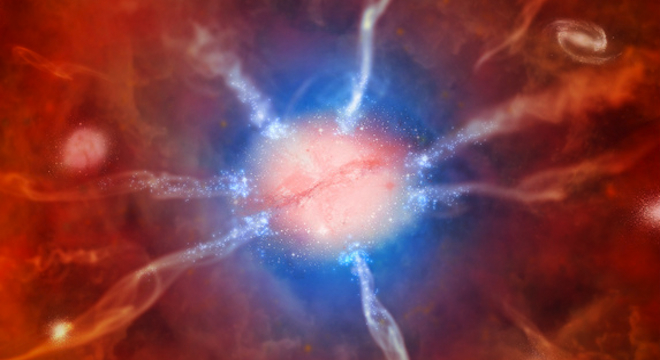Scientists using a NASA X-ray space telescope have discovered that an exceptionally bright cluster of galaxies is giving birth to stars faster than any other cluster in the known universe, a finding that changes the conventional wisdom of star-formation throughout the cosmos.
The galaxy at the center of the “Phoenix” galaxy cluster, located some 5.7 billion light-years from Earth in the Phoenix constellation, is spitting out stars at a rate of 740 per year, according to a new analysis made using NASA’s Chandra X-ray orbital space telescope, which is managed by the Smithsonian out of Cambridge, Massachusetts. The entire cluster itself is pumping out 3,820 solar masses a year, according to the researchers.
Comparatively, the Milky Way forms stars at an average rate of just one solar mass (one star equal in mass to Earth’s Sun) per year. Other galaxies form an average of one star every 20 years.
The new analysis also finds that the Phoenix galaxy cluster contains an unusually high amount of cooling gas near its center, which may be driving the star formation.
This is unprecedented, given that most galaxy clusters that have cooling gas at their centers don’t form many stars at all and haven’t for billions of years, a condition thought to be due to the effects of energy released by the supermassive black holes at their centers.
“These findings provide new insight into how the most massive galaxies in the Universe may have acquired their stars,” said Michael McDonald, a scientist with the Massachusetts Institute of Technology (MIT), who led the study, in an email to TPM. “Our current understanding is that these massive galaxies assemble via mergers with smaller galaxies, but in this one cluster it looks like cooling-induced starbursts may be an equally important process.”
“What we are investigating here is the early stage of star formation and the very end product — the new stars themselves,” added Megan Donahue, an astronomy professor at Michigan State University, in an email to TPM.
NASA released the following video animation showing the star-formation process thought to be taking place in the Phoenix cluster, with a reservoir of hot gas (represented in red) rapidly cooling (turning to blue) and flowing inwards, releasing X-rays, a transition that appears to be driving the birth of new stars along giant filaments of gas (the white lines).
The hot reservoir of gas that’s driving this process is more massive than all of the stars in the entire galaxy cluster, and that’s saying something, given that the cluster itself contains “roughly a couple thousand Milky Way-sized galaxies,” according to McDonald.
On average, the galaxy cluster is producing about two stars a day, McDonald said, but that’s just an aggregate rate.
“We don’t expect the star formation to be steady, but rather happen in waves or bursts,” McDonald explained to TPM.
As for whether the Milky Way’s own galaxy cluster, the Virgo Supercluster, went through a similar phase in its development, the jury is still out.
“Other clusters very well could have gone through similar ‘growth spurts’ in the past,” McDonald said. “We know that it had to be at least several billions of years ago, because the stars in most other systems are quite old.”
Also, it’s still a mystery why the supermassive black hole at the center of the Phoenix cluster isn’t slowing down the star production rate to more normal levels seen throughout the rest of the universe.
“I suspect the answer is that this is a temporary situation,” said Donahue. “We test that hypothesis by looking at a large sample of clusters, and seeing what fraction of them are in this highly productive state. If only a tiny fraction of all clusters are doing this, we know that it’s likely a very short-term or rare condition.”
McDonald his colleagues’ discovery is detailed further in a paper published in the August 16 edition of the journal Nature. Donahue provided comment on the findings presented in the paper.
Editor’s note: This story was updated to clarify that the central galaxy in the Phoenix cluster is responsible for producing 740 solar masses on its own. The headline was also changed from “Anywhere in the Known Universe” to “Any”, referring to any galaxy cluster, reflecting the fact that, according to Megan Donahue, “there are extremely distant starburst galaxies at high redshift making stars much faster than this galaxy, at thousands of solar masses per year,” but that they are not found in clusters, as is the case with this particularly galaxy in the Phoenix cluster.






